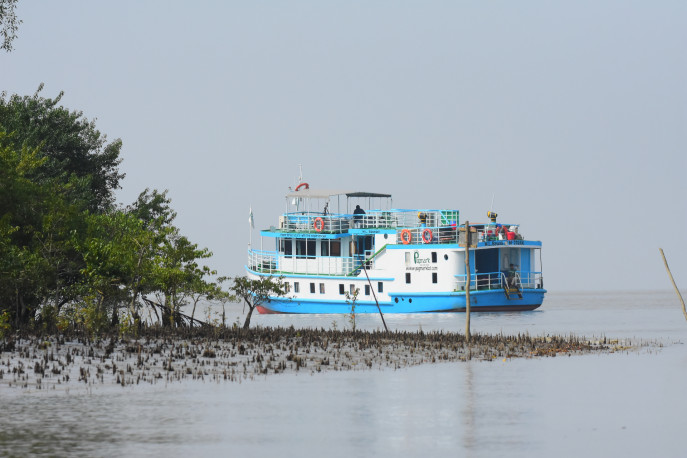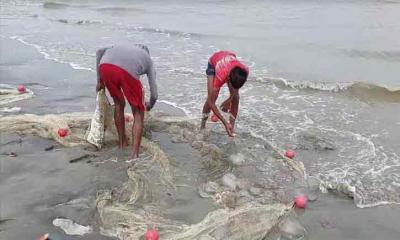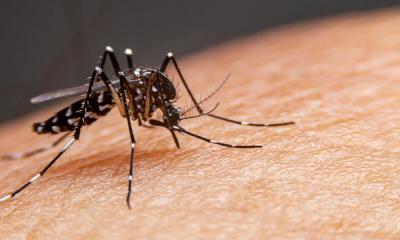Vessel movement doubled
Moving through the sanctuaries
15 capsizes in 7 years
River erosion makes matters worse
Wildlife trafficking
Over the past dozen years, river transport on the Bangladesh-India river route through the Sundarbans has almost doubled. According to BIWTA standard practice, no vessel is to travel through the Sundarbans, the world's largest mangrove forest, from sunset to sunrise. However, that is being ignored. This unregulated commute by vessels is eroding the river banks. The forest area is shrinking. The river is being polluted when vessels often sink carrying a cargo of coal, cement raw materials, etc. This is a threat to the biodiversity of the forest.
In 1972 Bangladesh and India signed the first Protocol on Inland Water Transit and Trade, aimed at expanding trade between the two countries by river routes. Under this protocol, a few hundred cargo-carrying lighter vessels use the river route of the two countries every month. These vessels start from Hemnagar in India, cross the Raimangal river border, and travel down Sundarbans' Raimangal, Kanchikata, Malancha, Arpangashia, and Batula rivers to the Angtihara customs station in Koyra. After completing all the paperwork there, the vessels go through Sundarbans' Shakbaria, Bojboja, Aroya Shibsha, and Shibsha rivers to Mongla or Khulna via Nalian-Chalna. The route from Chalna to Raimangal is almost 122km. Of this, around 100km is within the Sundarbans. It takes at least 8 hours for the vessels to cross this distance.
Chief Forest Conservator of Khulna zone, Mihir Kumar Doe, said, that unregulated vessel movement through the river will naturally damage the biodiversity. More alarming is that the movement of vessels has multiplied hugely. This is harming the forest. A research initiative has been taken up, funded by the World Bank, to see how far the damage is taking place. Action will be taken once the report is final According to records at Angtihara Customs Station, in the year 2023, a total of 8,342 vessels moved between the two countries through this inland water route. In a month, 695 vessels used this route on average. In 2022 this number was 837. In the first two months of this year, 701 vessels used the route on average.
Even a decade or so ago, the number of vessels using this route was almost half. In 2012, a total of 4,281 vessels used this route. The average number of vessels using the route per month had been 357. In 2013 the total number of vessels using this route was 4,328, which was 361 on average per month.
Sources in Bangladesh Inland Water Transport Authority (BIWTA) said that over the past two decades, the cement industry expanded exponentially in the country. The cement raw material, fly ash, was mostly imported from India. As the cement factories were on the river banks, this river route was used to bring in the fly ash. It is also more cost-effective to use the river route than a land route to transport goods. That is why vessel movement has increased. In 1992 the Sundarbans was recognised as a Ramsar site for its bounty of biodiversity. In 1997 UNESCO recognised the Sundarbans as a World Heritage, following an application by the Bangladesh government. Along this river route are Pankhali, Dhangmari, the Shibsha wildlife (dolphins) sanctuary and the Sundarbans West wildlife sanctuary. Here lives the endangered Irrawaddy and Gangetic dolphin. Experts feel that one of the main reasons endangering dolphins is excessive movement of river vessels. According to the Wildlife Conservation Act 2012, any work in the habitat of endangered species that is harmful to their natural movement and breeding is prohibited.
As it is, the movement of engine-run vessels through the Sundarbans is harmful to the rich biodiversity and the sensitive ecology. Animals like the Bengal tiger, deer, dolphin, and crocodile are the most threatened.
Experts say, more harm is done at night than in the day. That is when the animals rest. The harsh noise and the waves create panic among the animals. The Forest Act, the Wildlife Conservation Act, and the Sundarbans tourist regulations prohibit the movement of any kind of engine-run vessels in the forest at night.
According to the forest department, over the past seven years around 15 vessels carrying coal, boulders and fly ash have capsized, mostly in and around the Sundarbans. On 29 December, a cargo vessel carrying fly ash capsized in the river Shibsha, just three kilometres from the Sundarbans. The vessel was salvaged around two months later. By then around 1,500 metric tonnes of fly ash had spread through the river.
Earlier in 2022, Sea Gentle, a vessel carrying fly ash, sunk in Sundarbans' Shakbaria river near the Angtihara customs station. River erosion has increased in a new river of the Sundarbans due to the increased movement of vessels. The erosion is harming the trees. Erosion was recently visible at the rivers Kanchikata and Jhapjhapia. The local forestry officers say the erosion of the river banks is decreasing the size of the forest. Rivers that used to be 20 to 30 metres in width are now 50 to 60 metres.
There are allegations that the vessel officers are used to smuggle deer meat. On 6 March last year four crew of a vessel, in possession of deer meat, were accosted by local people near the Angtihara bazaar and handed over to the police. Resident Rafiqul Islam said, that after work at the Angtihara customs station, every day 20 to 25 vessels leave. It is heard that the officers of these vessels are used to smuggle venison.
Forest officer Abu Naser Mohsin Hossain said it is not the jurisdiction of the forest department to check the cargo of the vessels. There is always the apprehension of wildlife being smuggled through these routes.
At the initiative of the government, tourist trips were arranged by the Dhaka-Kolkata river route in 2019. It was shut down in March the same year as it was not profitable. But in November last year, passenger vessels began using the Dhaka-Kolkata route. Bangladesh's tourist vessel MV Rajarhat-C', has been regularly carrying tourists.
Recently several luxury Indian cruise vessels came by river to Bangladesh. The first cruise vessel came in February last year and the British newspaper The Guardian published an article about how this luxury cruise was a threat to the Gangetic dolphin.
ZH






